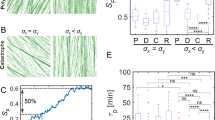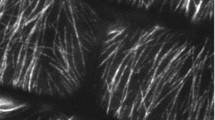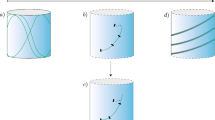Abstract
The highly orientationally ordered cortical microtubule array in plant cells is a key component for cell growth and development. Recent experimental and computational work has shown that the anisotropic nucleation of new microtubules from pre-existing microtubules has a major effect on the alignment process. We formulate a theoretical model to investigate the role of the microtubule-bound nucleation on the self-organization of the dynamical cortical microtubules. A bifurcation analysis of the stability of the disordered phase of the model reveals that the effective degree of co-aligned nucleation is the main determinant of the location of the transition. Increased co-aligned nucleation creates a positive feedback effect on the ordering process that can significantly widen the ordered region. We validate these predictions by comparing to the results of particle-based simulations.




Similar content being viewed by others
References
Allard JF, Wasteneys GO, Cytrynbaum EN (2010) Mechanisms of self-organization of cortical microtubules in plants revealed by computational simulations. Mol Biol Cell 21:278–286
Burk DH, Zhong R, Ye Z-H (2007) The katanin microtubule severing protein in plants. J Integr Plant Biol 49(8):1174–1182
Chan J, Sambade A, Calder G, Lloyd C (2009) Arabidopsis cortical microtubules are initiated along, as well as branching from, existing microtubules. Plant Cell 21:2298–2306
Deinum EE, Tindemans SH, Mulder BM (2011) Taking directions: the role of microtubule-bound nucleation in the self-organization of the plant cortical array. Phys Biol 8:056002
Deinum EE, Mulder BM (2013) Modelling the role of microtubules in plant cell morphology. Curr Opin Plant Biol 16(6):688–692
Desai A, Mitchison TJ (1997) Microtubule polymerization dynamics. Annu Rev Cell Dev Biol 13:83–117
Dixit R, Cyr R (2004) Encounters between dynamic cortical microtubules promote ordering of the cortical array through angle-dependent modifications of microtubule behavior. Plant Cell 16:3274–3284
Dogterom M, Leibler S (1993) Physical aspects of the growth and regulation of microtubule structures. Phys Rev Lett 70:1347–1350
Ehrhardt DW, Shaw SL (2006) Microtubule dynamics and organization in the plant cortical array. Ann Rev Plant Biol 57:859–875
Eren EC, Dixit R, Gautam N (2010) A 3d computer simulation model reveals the mechanisms for self-organization of plant cortical microtubules into oblique arrays. Mol Biol Cell 21:2674–2684
Gutierrez R, Lindeboom JJ, Paredez AR, Emons AMC, Ehrhardt DW (2009) Arabidopsis cortical microtubules position cellulose synthase delivery to the plasma membrane and interact with cellulose synthase trafficking compartments. Nat Cell Biol 11:797–806
Hawkins RJ, Tindemans SH, Mulder BM (2010) Model for the orientational ordering of the plant microtubule cortical array. Phys Rev E 82:011911
Luders J, Stearns T (2007) Microtubule-organizing centres: a re-evaluation. Nat Rev Mol Cell Biol 8:161–167
Murata T, Sonobe S, Baskin TI, Hyodo S, Hasezawa S, Nagata T, Horio T, Hasebe M (2005) Microtubule-dependent microtubule nucleation based on recruitment of big gamma-tubulin in higher plants. Nat Cell Biol 7:961–968
Nakamura M, Ehrhardt DW, Hashimoto T (2010) Microtubule and katanin-dependent dynamics of microtubule nucleation complexes in the acentrosomal Arabidopsis cortical array. Nat Cell Biol 12:1064–1070
Paredez AR, Somerville CR, Ehrhardt DW (2006) Visualization of cellulose synthase demonstrates functional association with microtubules. Science 312(5779):1491–1495
Shaw SL, Dumais J, Long SR (2000) Cell surface expansion in polarly growing root hairs of Medicago truncatula. Plant Physiol 124(3):959–970
Tindemans SH (2009) Biomolecular design elements: cortical microtubules and DNA-coated colloids. PhD thesis, Wageningen University
Tindemans SH, Hawkins RJ, Mulder BM (2010) Survival of the aligned: ordering of the plant cortical microtubule array. Phys Rev Lett 104:058103
Waterman-Storer CM, Salmon ED (1997) Microtubule dynamics. Curr Biol 7:R369–R372
Acknowledgments
This work is part of the research programme of the Foundation for Fundamental Research on Matter (FOM), which is part of the Netherlands Organisation for Scientific Research (NWO).
Author information
Authors and Affiliations
Corresponding author
Rights and permissions
About this article
Cite this article
Foteinopoulos, P., Mulder, B.M. The Effect of Anisotropic Microtubule-Bound Nucleations on Ordering in the Plant Cortical Array. Bull Math Biol 76, 2907–2922 (2014). https://doi.org/10.1007/s11538-014-0039-3
Received:
Accepted:
Published:
Issue Date:
DOI: https://doi.org/10.1007/s11538-014-0039-3




